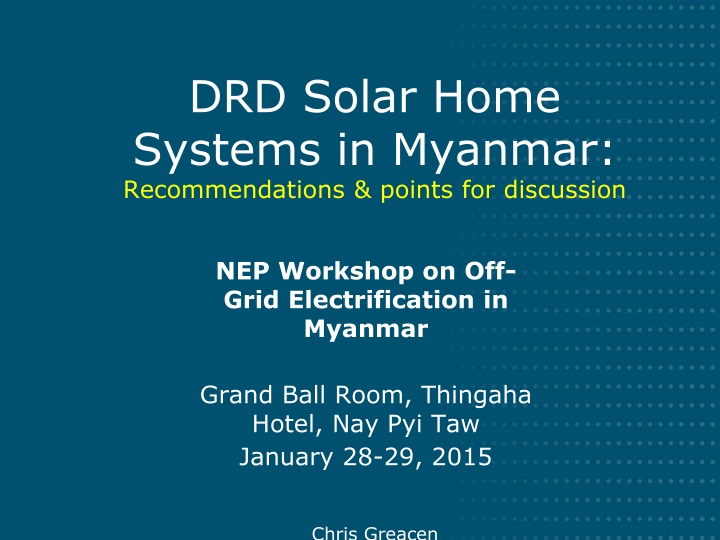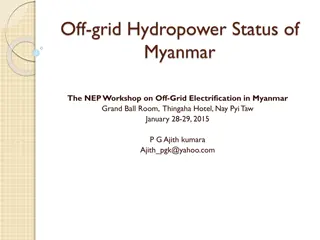Recommendations for Enhancing DRD Solar Home Systems in Myanmar
Recommendations for improving DRD Solar Home Systems in Myanmar include technical enhancements, policy integration, quality standards, funding sources, training initiatives, and environmental considerations. Suggestions range from revising system specifications to integrating geospatial planning into village selection processes and enhancing organizational capacity.
Download Presentation

Please find below an Image/Link to download the presentation.
The content on the website is provided AS IS for your information and personal use only. It may not be sold, licensed, or shared on other websites without obtaining consent from the author.If you encounter any issues during the download, it is possible that the publisher has removed the file from their server.
You are allowed to download the files provided on this website for personal or commercial use, subject to the condition that they are used lawfully. All files are the property of their respective owners.
The content on the website is provided AS IS for your information and personal use only. It may not be sold, licensed, or shared on other websites without obtaining consent from the author.
E N D
Presentation Transcript
DRD Solar Home Systems in Myanmar: Recommendations & points for discussion NEP Workshop on Off- Grid Electrification in Myanmar Grand Ball Room, Thingaha Hotel, Nay Pyi Taw January 28-29, 2015 Chris Greacen
Outline Technical Improve DRD SHS design specifications (short term) Revise DRD SHS specs to include quality standards Policy, planning & regulation Integrate NEP geospatial plan into village selection Integrate sources of funding SPP/Mini-grid Regulatory framework Financing & subsidies Redesign DRD SHS program (BIG!) Organizational process & intuitional capacity Training for DRD Training & certification for installers Training for users (DVD & booklet) Public exposure to quality products Product review app Environmental and Social Battery recycling 2
Technical SHORT TERM MEASURE Improve DRD SHS design specifications Activity: improve SHS system design, increasing reliability and efficiency through removing inverter, enabling reduction in PV, battery capacity Reason needed: Inverter is inefficient & failure-prone and not needed for lights, TV, cell phone charging, fan. Qty Item Current DRD Specifications 80-90 peak watts Recommended Capacity 1 Solar panel 60 peak watts 1 Deep cycle battery 65 Ah 60 Ah 1 Charge Controller 10 A 10 A 1 Tube lamp 20 watts (cfl) 8-10 watts (LED) 2 LED lamps 3 to 5 watts 3 to 5 watts 1 0 Inverter 300 watts None Quality standards None except warranty Certified components, adequate wiring, proper installation, warranty 3
Technical Revise DRD SHS specifications to include quality standards Activity: Reform the DRD SHS specifications so that any SHS that receive DRD subsidies must use equipment that meets certain quality standards, and that the system is correctly installed. Reason needed: Current DRD specifications are insufficient to ensure quality Example from 44-page list of approved type-tested equipment for IDCOL Source: http://www.idcol.org/download/260275fd02d802e8ded266af02d51ea5.pdf 4
Policy, planning & regulation Integrate NEP geospatial plan into village selection Activity: Adjust DRD SHS village selection process to include consideration of National Electrification Plan. Share NEP geospatial planning documents with township level (and above) DRD staff Update NEP regularly Develop clear criterion for village or household eligibility, e.g. SHS for villages not expected to be served by the grid within three (five?) years. Reason needed: As NEP is only recently completed, it has no connection with the selection of villages in the DRD SHS program. Risk of repeated selection of villages that may be quickly connected to the main grid. 5
Policy, planning & regulation Integrate NEP geospatial plan into village selection Source: Columbia Earth Institute, 2014. Electrification Planning for Myanmar: Methodology and Sample Results for: Kayin State and Chin State. March 19, Nay Pyi Taw, Myanmar 6
Policy, planning & regulation Integrate sources of funding beyond DRD budget Activity: Develop an institution or a financial account within DRD that can pool multiple sources of funding earmarked for rural energy support. Example: Rural Energy Agencies (REAs) in several African countries Reason needed: Coordinated funding energy access necessary to avoid proliferation of projects and programs working at cross purposes, duplicating efforts in some areas and leaving gaps in others. 7
Subsidy and finance Redesign DRD SHS program Activity: Consider redesign of DRD SHS program to reduce subsidy amount, increase customer choice, integrate with commercial sales of SHS, enhance sustainability. Reason needed: Improve efficiency of government budget use. Program redesign is a big undertaking requires answers to difficult questions 8
Policy, planning & regulation Redesign DRD SHS program (continued) Key questions include: Should there be user subsidies? If so to what amount? Bangladesh = Initially $90/SHS, now $20/SHS; Lighting Global type program no subsidy Subsidy for market development? Specification: Fixed capacity vs. service level, or none? Fixed capacity: e.g. 80 watt PV, 65 Ah battery Service level: e.g. 3@180 lumen lights 4 hrs/night Micro-financing? More information needed on willingness to pay, elasticity of demand with respect to price 9
Organizational process and institutional capacity Training for DRD Activity: targeted training to the DRD on SHS. Topics to include: SHS failure modes Quality certification Specific information on how quality equipment and installation can help mitigate failure modes. Designing and running a sustainable program Reason needed: DRD is responsible for off-grid electrification but its engineering strengths lie largely in civil and mechanical engineering. 10
Organizational process and institutional capacity Training and certification for installers Activity: a train-the-trainer course and accreditation procedure for institutions that teach a course of between 4 to 7 days on SHS Content would follow accepted established international curriculum for SHS installer certification Reason needed: All SHS visited in the course of this research had shortfalls that compromise safe and efficient performance. 11
Organizational process and institutional capacity Library of best-practice SHS videos for installers Activity: Create a library of Burmese language 3-10 minute videos of best SHS practices calibrated to the Myanmar context. Content would vary from operational and basic maintenance to more technical material related to system design and installation best-practice. Reason needed: Video format takes advantage of the fact that DVD players and smart phones are already common in rural areas, video is a medium easily copied, and combines audio/visual learning. 12
Organizational process and institutional capacity videos and booklet for SHS users Activity: Create a simple pictorial booklet and videos in Burmese for best SHS user practices, calibrated to the Myanmar context. Reason needed: Poor understanding by system users of SHS installation, operation, and maintenance severely compromises system performance. 13
Organizational process and institutional capacity Burmese smartphone SHS product review app Activity: Create and market a Burmese-language smart-phone app for solar product review and discussion. Reason needed: Consumers have little information at their disposal to make purchase decisions on solar equipment. 14
Organizational process and institutional capacity Public exposure to quality products Activity #1: Convene or facilitate exhibitions in which manufacturers can showcase quality equipment; Activity #2: Use multiple media channels to provide information on products that pass quality standards. Recommend draw from: IDCOL s list of approved SHS components; and www.idcol.org/download/260275fd02d802e8ded266af02d51ea5.pdf Global Lighting s website of products that have met Lighting Global Quality Standards. www.lightingglobal.org/products/?view=grid Reason needed: Widespread use of reliable, affordable SHS will be more achievable if the general public has information about the best products available. 15
Environmental and Social Battery recycling Activity: Investigate existing lead acid recycling practices and whether existing recyclers can scale up to match demand as SHS usage grows. Design & implement battery collection and recycling program if necessary. Reason needed: Lead is a potent neurotoxin and it is important to ensure that discarded SHS batteries do not pollute the environment. Sulfuric acid from batteries is also a hazard. 16
Summary Area Policy, planning & regulation Activity Integrate NEP geospatial plan into village selection Integrate sources of funding Revise DRD SHS specs to include quality standards Improve DRD SHS design specifications Redesign DRD SHS program (BIG!) Training for DRD Timeframe 1 year 1 year 6 months Technical 2 months 1-2 years 3 months Financing & subsidies Organizational process & intuitional capacity Training & certification for installers 6 months to 1 year 1 year 6 months 6 months 1-2 years Training for users Public exposure to quality products Product review app Battery recycling Environmental and Social Slide 17
Thank you! Chris Greacen chrisgreacen@gmail.com 18























